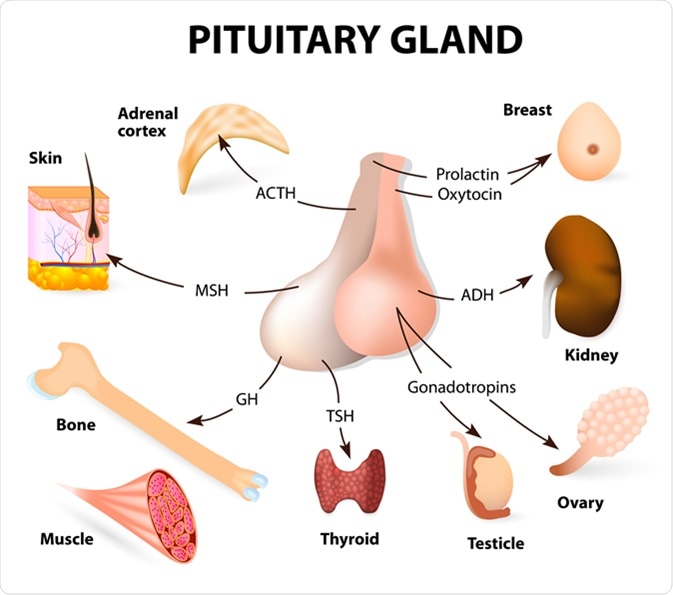The pituitary gland is a small, but incredibly productive and important piece of hormone-secreting (‘endocrine’) tissue located deep within the brain.
It regulates many fundamental body processes. It is protected within a shallow bony socket called the sella turcica (‘Turkish saddle’) located on the sphenoid bone, right behind the nose. It receives other hormones to regulate its output from the hypothalamus, which is above it in the interbrain.
.jpg)
Brain anatomy PITUITARY GLAND - cross section. Image Credit: CLIPAREA l Custom media / Shutterstock
Types of hormones
The pituitary gland secretes two types of hormones, those which regulate the working of other endocrine glands and those which directly affect physiological functions. Its hormones can also be classified as those from the anterior pituitary, the posterior pituitary, and the pars intermedius (i.e. ‘the middle piece’).

Pituitary hormone functions. Image Credit: Designua / Shutterstock
Anterior Lobe Hormones
The anterior lobe is the larger part of the gland, making up about 75% of its tissue. It secretes some hormones which regulate other glands, namely:
- Thyroid-stimulating hormone or TSH, a glycoprotein molecule which stimulates the cells of the thyroid gland to make more thyroid hormone which produces powerful effects on many and varied metabolic functions. These include mental state, heart rate, gut motility, brain development in the fetus, and bone maturation. A significant deficiency of TSH causes thyroid hormone levels to drop, producing hypothyroidism.
- Adrenocorticotropic hormone or ACTH, which is a promoter of adrenal cortical hormone secretion. The adrenal is a small gland perched atop the kidney, with an outer cortex and an inner medulla. The cortex secretes cortisol in response to ACTH. This is essential for normal body functioning, as severe cortisol deficiency causes death. Cortisol is powerful in causing the many adaptations necessary to face a sudden and unexpected stimulus, including a rise in blood pressure, heart rate, breathing, and blood sugar.
- Follicle-stimulating hormone (FSH) and luteinizing hormone (LH) are usually taken together as both of them have interrelated actions. They control the production of hormones (estrogen and testosterone) in the male and female reproductive glands, which are the testes and the ovaries, respectively. Their actions are essential for the production of eggs and sperm cells in females and males, respectively.
They also produce another set of hormones that act on the body directly. These include:
- Growth hormone (GH) or somatotropic hormone, which is a peptide hormone that promotes the increase in bulk and strength of the bones, the fat, the muscle, the liver, and other tissues. It also increases the blood levels of glucose and of free fatty acids as an alternative source of energy. Its secretion is not steady but pulsatile, and varies with the time of day or night. Its levels peak during sleep at night, and are highest in the adolescent period when the growth spurt occurs. It acts by stimulating the production of Insulin-like Growth Factor 1 (IGF-1) from the liver, which is the final mediator of growth-promoting effects in the body.
- Prolactin, which is a hormone which causes growth of the breast tissue during the growth spurt. It stimulates the breast primed by estrogen and progesterone (during pregnancy) to secrete milk. It negatively affects the secretion of the hypothalamic hormone which stimulates the release of FSH and LH from the pituitary, and so prevents normal egg release. It is maximally secreted during exercise, or during some types of stress, as well as following nipple stimulation. Its secretion is reduced by dopamine in the hypothalamus.
The hormones are regulated in two ways - by hypothalamic hormones which act to either promote or reduce pituitary hormone secretion, and by feedback regulation. The latter term refers to an action whereby a hormone released by a target organ binds to receptors in the pituitary gland and inhibits further release of the stimulating hormone for that organ.
For instance, high levels of thyroid hormone prevent the pituitary secretion of further TSH, which cause the thyroid to produce less hormone as a result. This is a negative feedback loop. If the thyroid hormone level is too low, on the other hand, the hypothalamo-pituitary unit acts together to increase the secretion of TSH and thus increases thyroid hormone production.
Posterior Lobe Hormones
The posterior pituitary gland is actually more a part of the hypothalamus, being a landing point for the axons or nerve fibers extending from nerve cells there. It stores hormones made by these nerve cells.
These include:
- Oxytocin, which is a hormone which causes the uterus to contract during labor, expelling the baby. It also causes the breasts to expel milk by making the myoepithelial cells surrounding the milk ducts contract, squeezing the milk out of the ducts. Its levels are high in laboring and nursing women. It is given to women who need to go into labor but whose labor pains are not beginning, or to women with weak labor pains who need to have more forceful contractions, as an intravenous drip.
- Vasopressin or antidiuretic hormone (ADH), which regulates the salt and water balance in the body by acting upon the kidney and the blood vessels to reduce the amount of water that is excreted and to push up the blood pressure. Its secretion goes up when the blood osmolality (solute concentration) drops, or the blood pressure is low.
Pars intermedia Hormones
This is the part of the pituitary that lies between the anterior and posterior parts, and produces a single hormone called melanocyte-stimulating hormone (MSH) or intermedin. This causes the skin cells to produce more melanin or skin pigment when exposed to sunlight. This protects the skin from damage by the solar ultraviolet rays. It also has an effect upon the brain nerve cells that control both the appetite and libido.
.jpg)
